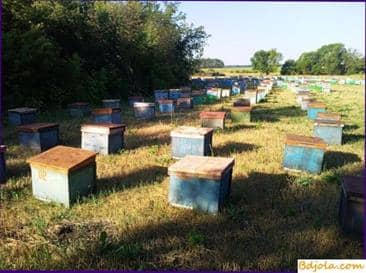Wax productivity of the apiary

The increase in wax productivity is very important, and for many apiaries of Ukraine – the main link in their work. In order to achieve an increase in the yield of wax in the apiary, that is, an increase in the productivity of bee colonies by wax, it is necessary:
1. create for bee families such conditions under which the bees most abundantly would allocate wax throughout the spring and summer part of the beekeeping season;
2. Take measures to collect the maximum amount of bees allocated by bees;
3. Do not allow loss of wax when storing the collected wax raw materials and during processing it to wax.
Bees excrete wax when they eat abundantly. They eat most abundantly at a time when they process a large amount of nectar entering honey, and when the presence of a bribe coincides with a large number of broods in the family. Researches of scientists have shown that waxes that process nectar in honey and feed brood most of all give out wax. The more abundant and durable the nectar enters the beehive, the more bees are allocated by the bees.
Therefore, providing bees with a long and abundant bribe, that is, a good feed base, is the most important and indispensable condition for the separation of wax. It is estimated that with a good, long and uninterrupted bribe throughout the spring-summer period, bees of one strong family can allocate 7-8 kg of wax. If the conditions for bees are poor, especially if there is no bribe, then brood rearing in families is greatly reduced and bees waxing stops completely.
At present, it has been established by precise experiments that, with abundant nutrition during the processing of nectar in honey and the brood rearing, the wax is released by the bees involuntarily, without unnecessary costs of honey. This valuable property of bees should be used in every possible way. It is also confirmed by the practice of all advanced beekeepers
The stronger the family, that is, the more bees and brood in them, the better in them conditions for the allocation of wax and the more it stands bees with a bribe. Hence – the content of strong families is one of the important techniques that contribute to increasing the wax productivity of bees.
Most of all, waxes are given to bees of those families who are in the so-called working condition, that is, they do not prepare for swarming. In preparation for swarming, bees reduce the allocation of wax and even partially spoil freshly built honeycombs. Therefore, maintenance of working conditions in families, especially during a bribe, by timely expansion of nests, increased ventilation and other measures is necessary.
The isolation of wax almost ceases in a bezmatovochnaya family. Consequently, throughout the entire season, care should be taken to ensure that the families have fetuses. It is necessary to avoid using those tricks in which the family during a bribe remains for a long time without a mouthpiece.
Thus, in order to get a large amount of wax from the bee family, it is necessary, first of all, to create conditions for the best allocation of it by bees. However, in the practice of beekeeping, there are often cases when bees provided with good bribe conditions during the season have given out a lot of wax, and the beekeeper has received it from bee colonies a little. This happens, for example, when, due to the fault of the beekeeper in the nests of families, there is no place for honeycombs to be built by the bees.
The matter is that the beekeeper receives wax from bee colonies not in the form of separate wax plates, allocated by bees, but mainly in the form of honeycombs or their firstfruits, built by bees from these wax plates. For the construction of new cells, in addition to the above conditions, it is necessary to have an empty space not filled with cells in the nest, where these cells could be built.
If there is no such space, then the bees, without the possibility to use wax plates, simply lose them, and only a small part of them is used to lengthen the (superstructure) of the walls of the honey cells during the so-called “whitewashing” of the honeycombs. That is why in order to get a large amount of wax from bee colonies, it is not enough to provide them only with the conditions of waxing, but they still need to create the proper conditions for waxwork, that is, the conditions that ensure the construction of honeycombs.
Observations show that bees build honeycombs most intensively when they are completely devoid of a nest. Thus, a natural swarm builds its nest very vigorously. Less intensively than the swarm, but nevertheless, the bees are building their nest with all their honeycomb nests. However, while most bees are forced to do some time almost exclusively by the construction of honeycombs. This construction goes out of communication, with the year’s feeding, and therefore the family spends (or lacks) a significant amount of feed.
Well build honeycomb honeycomb and when the nest becomes for the family close, but next to it, under it or above it there is room for its expansion. In this place new honeycombs are built.
Bees also build well just in case the integrity of the nest is broken, especially in its brood and near the summer (for example, when one of the middle nest frames is removed or its part is removed, especially the upper one).
The last two properties of bees are widely used in the practice of beekeeping: with the detachment of honeycombs on an artificial wax and when using empty, so-called building frames for waxwork.
Wax productivity of the apiary
